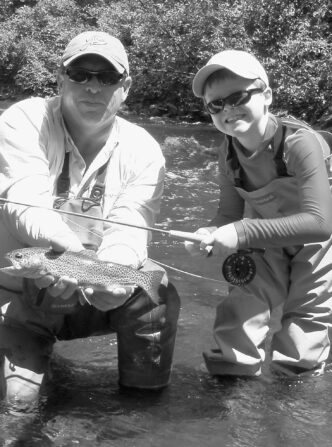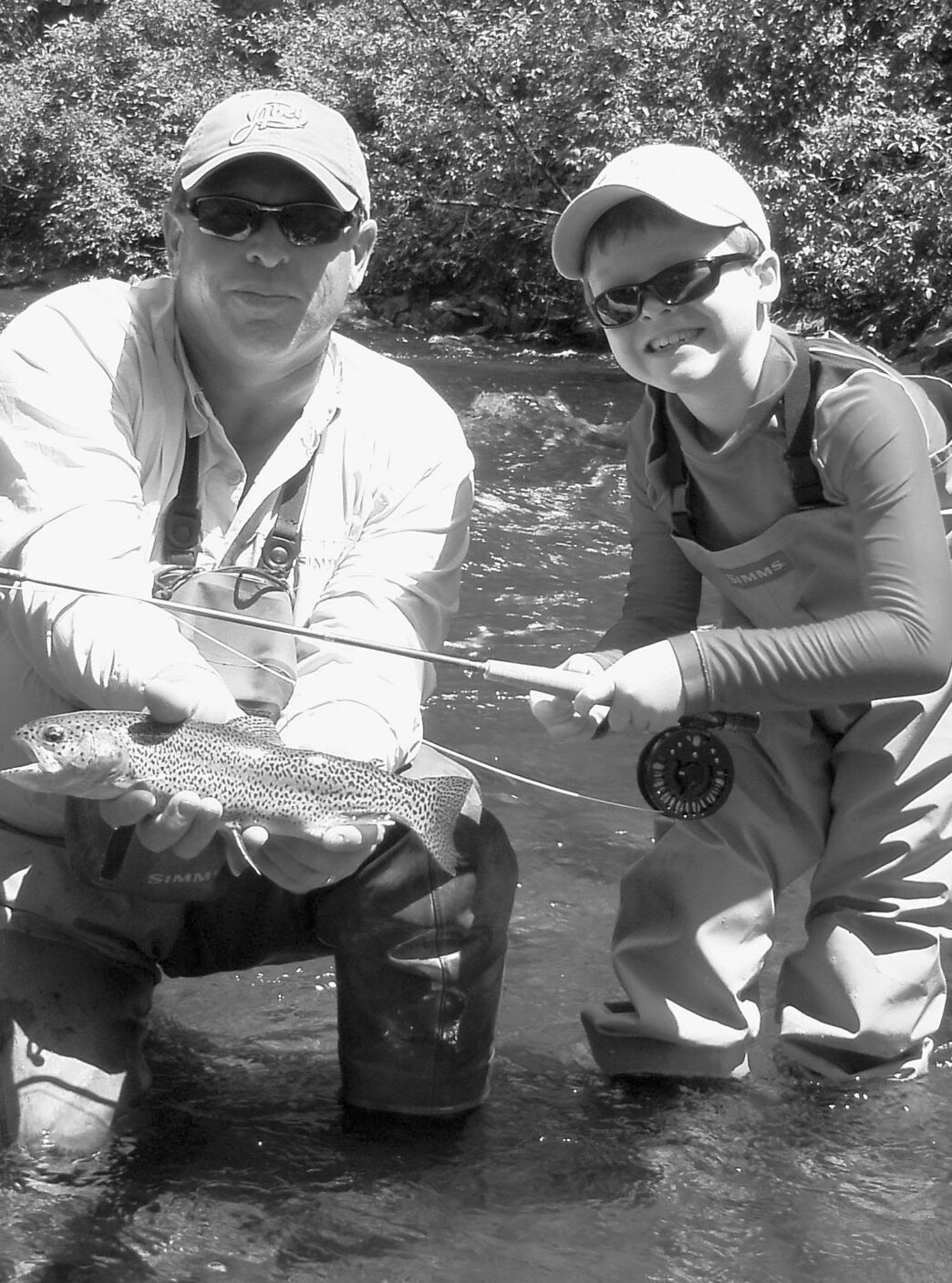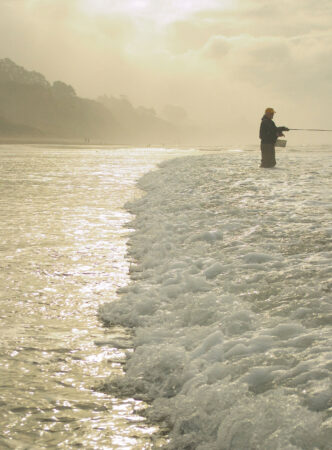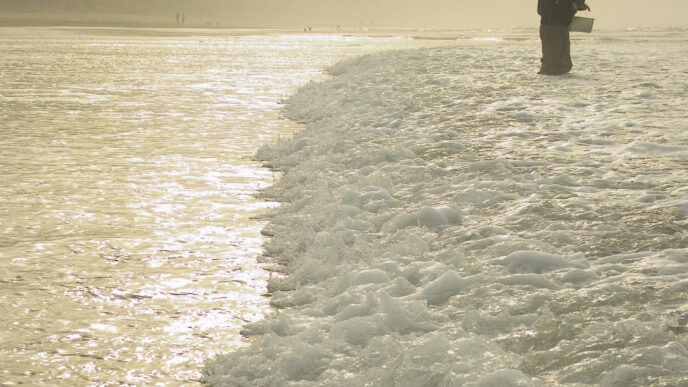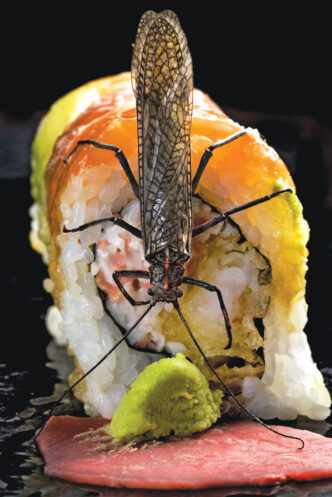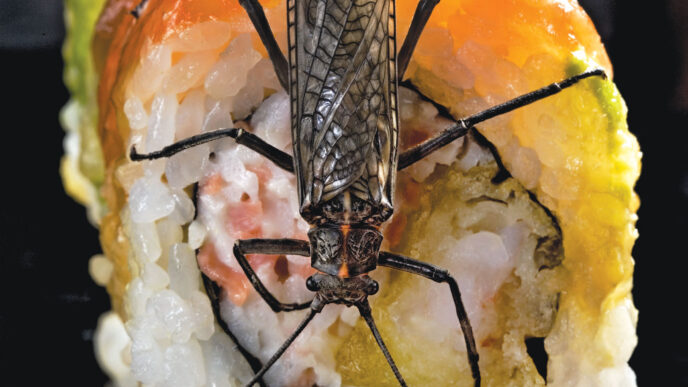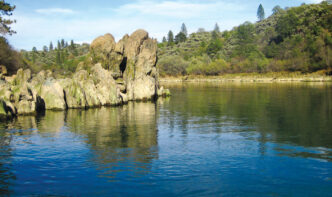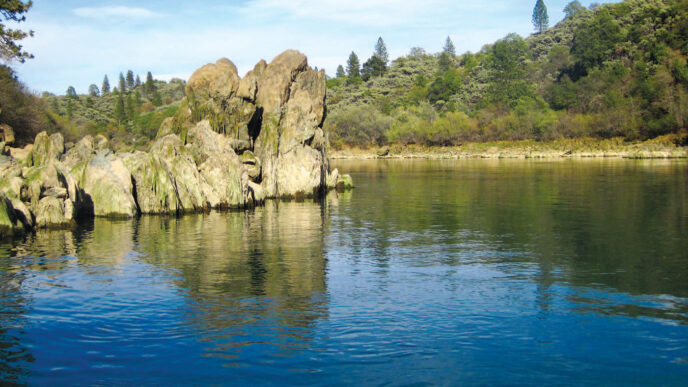Guides are pathfinders — they keep us from getting lost in the complexities of an unfamiliar angling environment and in the complexities of the sport itself. Few West Coast angling environments are as vast and as complex as the Sacramento–San Joaquin River Delta, and few guides there have been as successful over a long period as Mike Costello. A good guide establishes a comfort zone for his or her clients by exploring beyond what’s already known about a place, its environment, and its possibilities, and as you’ll see, that’s one of the elements that have contributed to Mike’s success as a guide.
Pathfinders also return to report what they have discovered, and Mike has done that by publishing Fly Fishing the California Delta (No Nonsense Fly Fishing Guidebooks, 2009), the definitive book for Delta flyrodders. He also recently published a book for kids aged 8 to 12, Where a Trout Calls Home: Imagination Meets Reality in the Life of a Rainbow Trout (Pacific Adventures Publishing, 2013) and started his own publishing company to produce it. Mike has been exploring the sport and communicating what he finds to the rest of us for a long time, so we thought it was time to ask him to tell us about himself.
Bud: What is it with Arizona? I asked Seth Norman how a kid from the desert ended up an angling writer, and even though you grew up fishing Lake Mohave — that is to say, a place that actually has a lot of water — it still seems to be a long, strange trip to end up a fly-fishing guide in Northern California. What was your career path, and how did it differ from the school/college/nine-to-five job that many of us followed? What brought you to Northern California?
Mike: I actually grew up in San Bernardino, California, but I spent a lot time fishing Lake Mohave on the Colorado River with my grandfather. We kept our boat at Katherine’s Landing, near Bullhead City, but we would explore the lake from Davis Dam up to the cold, fast-flowing water just below Hoover Dam. As a young boy, I was always fascinated by fish and by the angling exploits of my grandfather, Bob Costello. I guess he passed the fishing bug down to me.
Growing up in Southern California actually provided me with some wonderful angling opportunities. During my high school years in the early 1980s, my best friend, Jeff Solis, and I attempted to fish any water that might support aquatic life. These “fishing crusades” to public and sometimes “closed” waters only helped fuel this obsession.
When I graduated from Aquinas High School in 1985, Jeff presented me
with an Orvis Brook Trout 7-1/2 foot 4weight fly rod as a graduation present, and I gave him a North Face goose down jacket, because he always froze to death every time we fished the eastern Sierra. Now I was ready to do some serious fly fishing, and that summer, I tried out that new rod on Roderick Haig-Brown’s Campbell River, on Vancouver Island in British Columbia. I caught so many pink salmon on that ultralight rod that I destroyed the drag on my System One Scientific Angler fly reel. I was hooked for life, but I also had other major obligations, because I was to attend the University of California at Riverside on a baseball scholarship that fall. From the time I was a young kid, the only thing I had ever wanted was to be a professional baseball player, but for the first time in my life, I felt something else calling me. I watched the Lani Waller steelhead videos over and over, and although I hate to admit it, I started daydreaming in my classes about faraway rivers and lakes full of hard-fighting trout. When my time at U.C. Riverside ended, so did my baseball career. I was 21, and the only thing I could think about was fly fishing.
I packed up my truck, said goodbye to my family, and headed off to Basalt, Colorado, to follow my dream. I lived in a cabin right on the Frying Pan River and chased big rainbow and brown trout seven days a week. In early August 1990, Roy Palm, then the owner of Frying Pan Anglers, called me up and asked me if I wanted to do a guide trip for him the next day. I blurted out a very loud Yes! and my life has never been the same since.
After guiding full-time in Colorado for a little more than six years, I returned to California in 1996, but this time, I settled in the northern part of the state and immediately became addicted to pursuing steelhead and striped bass. I had fished Northern California before, but I had no idea how many wonderful fly-fishing opportunities exist in this part of the state. I often tell my customers that the Sacramento area has perhaps some of the best fly-fishing opportunities found anywhere in the world. Within a three-hour drive, you can be fishing world-class trout rivers, chasing wild steelhead and king salmon on a number of streams, landing trophy stripers and largemouth bass in an amazing estuary, or targeting American shad as they head upriver to spawn. It is truly a paradise for the fly angler.
Bud: In Fly Fishing the California Delta, you mention that you started out, as many of us did, as a conventional-gear angler, then switched to the long rod. What motivated the change for you?
Mike: I always think about my “gear days” when I was younger, and I would try to cast my grandfather’s Browning rod and Ambassador 4000 reel. The baitcasting reels were a little less refined back then, and if you lost thumb pressure, bad things would happen. Generally, it typically ended with me saying, “Grandpa, I have a little bit of a bird’s nest.” His response is better left to the imagination and should not be written down.
Actually, drifting worms under a bobber in a fast-moving river helped me as a fly angler years later. I learned to read water, understand drifts, and find fish way before I picked up a fly rod. I then graduated to casting Roostertail spinners under overhanging branches on the lower Owens River, just outside of Bishop, California. A little backhand flip cast, a slight wrist snap to get the blade turning. Then hang on when that 18-inch brown crushes your presentation. Still, something was missing in my angling pursuit.
I started to fish the wild trout rivers throughout California, and I caught trout on my barbless lures, but I noticed that the fly anglers caught many more. On our fishing excursions, my good friend Andy Zachery often would fly fish while I chucked hardware, and finally I decided it was time to make the change.
I was a self-taught fly fisher, and that had its challenges. I developed many bad habits, but the smallest progress left me thirsting for more knowledge. If I caught only one fish for the day on a fly, it was a huge success, and soon those one-fish days turned into many-fish days, and the last time I used a spinning rod was back in 1987. Today, I want to catch anything that swims, and I want to catch it on a fly rod.
Bud: You write that “by 1990, I had the ultimate job — I became a professional flyfishing guide. From Vancouver Island to the Florida Keys, I pursued fish with reckless vigor.” But I’ve often wondered if guiding actually is “the ultimate job” for a gonzo angler. I mean, you’re not actually fishing. Or are you? What motivates someone like you to be a guide? What are the rewards? It’s certainly not the way to get rich.
Mike: I always tell people that I am fishing through my clients. The environment, the hunt, the reward of seeing the finned creature up close — just because I am not holding the rod, feeling the grab, or cranking the reel, it is still an exhilarating experience. I have been alive roughly 16,750 days, and almost half of my life has been spent in the pursuit of fish.
I am challenged every day by my quarry. Unlike other sporting activities, where physical abilities can quite often dictate the outcome, in fishing, there is an unknown factor, and if that day you don’t solve it, there is not a damn thing you can do about it.
The rewards of being a fly-fishing guide extend way beyond the targeted prey. Spending day after day with Mother Nature has a way of putting a smile on your face, and the relationships you develop with customers over the years leads to many wonderful memories.
Bud: There’s a lot more to being a Delata guide than just loving fishing, being a people person, and knowing your stuff when it comes time to put lines in the water. You’re not just “Mike Costello,” you’re “Captain Mike Costello,” and you’ve had to receive a lot of training, certifications, even licenses. What’s that process like? And like many guides, you have a number of sponsors — tackle manufacturers and the like. How important are they to running a successful guiding operation?
Mike: I can honestly say that getting my Coast Guard captain license was very difficult, because I did not attend a maritime school, but instead studied on my own while still guiding trout anglers on the river six days a week. I would get off the water, head home, and hit the books. I did not pass all four exams the first time I took them, so I gave it another try, and lo and behold, I became “Captain Costello.”
I am a gear junkie, I like all of the new, cool fly-fishing equipment and clothing, and I enjoy selling it to my clients. When I go to work, I put on my uniform for that day, and whatever the conditions, I know that I am prepared to do my job. Quality is a necessity for me, and the tackle manufacturers I work with are a key ingredient in my success as a guide.
Bud: You’ve been guiding for a long time — according to something I read, for 22 years and five thousand days on the water. What obstacles have you encountered along the way? What advice would you give to someone who wants to be a guide?
Mike: Actually, I am currently in my twenty-forth year as a full-time fly-fishing guide. If one is to last in this occupation, you really have to be excited to go to work every day, and you must like people and have a tremendous amount of patience. It cannot be about the money or the glamour of being a famous fly fisher. Probably the most important thing to learn is to balance your fishing life with the rest of your everyday existence.
I have been very fortunate that over the last 12 years, I have been able to stay completely booked up over a year in advance. Guiding between 260 and 270 days a year, I give my clients their days, and if they need to move anything around, they let me know. That being said, I still remember a time in my guiding career when I had many days open, and I needed to make money to put food on the table and keep a roof over my head. I contacted local shops, I sent out mailers, and I hustled — whatever it took. I knew I was in this for the long haul.
I would tell those starting out in this industry that you have to be hungry and willing to push the envelope — traveling farther and staying on the water longer. “Fish harder” has always been my motto. I want my clients to have the best day of angling they’ve ever had, and I don’t want those fish to win for the day.
Bud: You literally wrote the book on fly fishing the Sacramento–San Joaquin Delta. What drew your focus there, and what continues to make it your primary focus? It’s not just a striper fishery — I’ve fished a 4-weight for bluegills there (and hooked a big carp on it — yikes). What species do you target, when, and why?
Mike: When I first moved to Discovery Bay, back in 1996, I had no clue what the fishery was really about. I knew there were stripers to be caught, but I targeted largemouth bass at first because I had fished for them before and had a small inkling of how to catch them. From 1996 to 2000, I fished the Delta around 60 to 80 days a year, and the rest of my days were spent chasing trout and steelhead on numerous Northern California rivers and streams.
Here was this vast body of water with over a thousand miles of waterways, and it was overwhelming. It is not predictable, like a trout stream. Tides move up and down, weather conditions sometimes make fishing difficult, and the fish travel, searching for food. It definitely is not a controlled environment, and in order to have more success, I knew I had to spend more time understanding it. Around 2001, I started exploring water outside of my normal comfort zone in the Delta, and what I found was amazing. The fishery in the Delta is vast, and I could find monster stripers swimming in its depths.
Eighty percent of my guide trips now are on the Delta, and I look forward to each excursion as an adventure and a challenge. Just the thought of hooking into a linesider of 40, 50, or possibly 60 pounds is enough to keep me going day after day.
Big stripers are not the only reward, though. The Delta is also one of the best largemouth fisheries in the United States, and recently, the smallmouth fishing has taken off for fly anglers. Add some excellent panfishing, sight fishing for carp, and hooking a king salmon on the fly, and it is easy to see why this is one of the best fisheries to be found anywhere.
Bud: What’s a typical rod/line/leader combination and assortment of flies for stripers in the Delta? For largemouths? For other species? If you were to give one piece of advice to a fly fisher who wants to visit the Delta, what would it be?
Mike: When fly fishing for stripers in the Delta, I recommend 9-foot 8-weight, 9weight, and 10-weight saltwater fly rods. I typically carry three rods, one with a fastsinking line, another with an intermediate sinking line, and one with a floating line for casting poppers. I prefer fly lines that are overweighted, because they are quicker to load and make it easier to cast the larger, heavier flies that we use. I use leader material that has a breaking strength of 20 to 25 pounds.
My fly of choice for sinking and intermediate lines is a Flashtail Clouser in chartreuse over white or black over chartreuse, tied on a 3/0 jig hook. A rattle is optional, but we have caught some monster stripers on Rattle Clousers. For surface fishing, my fly of choice is Charlie Bisharat’s Pole Dancer, the only popper that truly “walks the dog” with the side-to-side motion that imitates a distressed baitfish.
For largemouth fishing, I like to fish with 7-weight, 8-weight, and 9-weight rods f rom 7-1/2 to 9 feet long. Once again, I typically use overweighted lines to cast heavy flies. My favorite surface flies are Whitlock’s Swimming Frog and Pike Fly and Kevin Doran’s Rat.
When smallmouth fishing, I prefer 5weight and 6-weight fly rods, and I fish a popper-dropper combination. A small popper with a trailing Mini Clouser or Woolly Bugger can be very effective for catching bronzebacks in the Delta.
The best way to learn the Delta is to explore it at low tide. When structure and weed beds are visible, it is easy to find high-percentage spots where fish might feed. Also, do not get hung up fishing an area too long. Cover water. That next big school of fish could be right around the corner.
Bud: The Delta is a big place, and it’s best fished from a boat, but a lot of us don’t have boats (or obliging friends who own one) and can’t always fish with a guide, either. What options do anglers have for fishing afoot in the Delta?
Mike: Fishing the Delta by foot can be a challenge, but because a large part of it consists of levees, and because on some of these levees there are public roads, it is possible to locate a school of feeding stripers and fish them from the bank. The steep rocks along the levees can present walking problems, and the erratic feeding of stripers does not always mean they will remain with in casting range, but catching a nice fish from the bank is a very rewarding experience.
But you don’t need a 21-foot Boston Whaler to fish the Delta afloat. During the last few years, I have seen an increase in fly fishers using kayaks and other personal watercraft to access both largemouths and stripers in the Delta. Backend sloughs and areas that have five-mile per-hour boating speed limits allow anglers to target their quarry without the fear of being run over by power boats.
Bud: How have the Delta and its fishery changed during the years that you’ve been fishing and guiding there? How have you adapted?
Mike: When I first started fishing the Delta, in the mid-1990s, there was an abundance of striped bass. California Department of Fish and Game, as it was called back then, was raising juvenile stripers and stocking them in the Delta to keep population numbers up. This was mostly funded by the striper stamp that was purchased along with an annual fishing license. I think the population of fish peaked sometime between 2002 and 2005, and since then, there has been a decline, especially among fish over 10 pounds. Compounding this decline has been a decrease in forage fish that has resulted in certain areas that used to provide exceptional striper fishing now being devoid of fish. Ten years ago, during the fall months, an angler might encounter 20 to 30 boats inside flooded Mildred Island, chasing huge schools of striped bass. These days, from October to December, Mildred Island is often a ghost town.
My clients and I have adapted by covering more water and by incorporating new angling techniques, such as fishing with intermediate sinking lines in very shallow water. During the last six years, our biggest linesiders have mostly come from water less than five feet deep, with flies fished on an intermediate line. New fly-line technology makes it possible for us to fish large flies in skinny water with a slower retrieve than the older, faster-sinking lines allowed. The big fish then have a chance to home in on their prey before it is yanked out of their feeding zone, and that has led to our biggest striper to date, a 49inch fish with a 32-inch girth that topped out on my Boga Grip at 47 pounds.
Because striper and bait populations have decreased, the windows when stripers are feeding are shorter. Timing is everything. It’s also essential to be in the right area at specific tidal movements to experience success.
Bud: The future of the Delta currently is being contested. What do you see happening, and what do you anticipate will the consequences be for the Delta fishery?
Mike: I have always been an optimist, and I hope we do not ruin this amazing ecosystem. Everyone wants a piece of the pie — or in this case, water — I am hopeful that some solution can be reached so that all parties can be satisfied. In my opinion, there is enough water for anglers, farmers, and municipalities. Unfortunately, when greed is involved, there is often a loser. One of things that regularly goes unnoticed is how much the economy benefits from a healthy Delta. From an angling point of view, marinas, gas stations, and tackle shops need a healthy Delta in order to survive.
Bud: I’ve been focusing a lot on the Delta, but in fact, in addition to guiding there for stripers, largemouths, and smallmouths, you also guide on the lower Stanislaus, lower Mokelumne, and lower Sacramento Rivers, and you’ve written a book, Where a Trout Calls Home, that’s basically a biography of a trout’s life, written for kids. So you’re clearly also still a Trout Guy. When do you find time to target trout, and what keeps you interested in these fish?
Mike: I actually look forward to my days on the oars, drifting down a peaceful river, chasing those magnificent rainbow trout. I spend around 40 to 50 days a year guiding for trout, and it is the perfect break from my Delta guiding. I am fortunate that I have two great rivers, the Mokelumne and the Stanislaus, very close to my home in Woodbridge, and they offer the quintessential getaway. I am especially fond of drifting the Stanislaus River, because it is one of the few trout fisheries that provides excellent dry, nymph, and streamer fishing, and it also offers the opportunity to land some exceptional stripers.
The lower Sacramento River from Redding downstream to the town of Corning has always been one of my favorites, and every summer since 1998, I organize two-day campouts for my customers on this incredible trout fishery. Setting up tents with air mattresses, cooking a nice meal, and enjoying a wonderful fire beneath a starry sky on a remote island is still one of my favorite trips to do. With over 100 campouts to date, the trout fishing is often secondary to the camaraderie with my clients over the years.
Bud: What motivated you to write a kids’ book, and what motivated you to start your own publishing company to put it out?
Mike: I actually wrote the story several years before I ever started my Delta book, and my son, Connor, who is now 10 years old, was my inspiration. I wanted to capture the innocence of how I felt as a child looking into a river full of trout, but I also wanted to offer the reader a sort of realistic description of the dynamics of a trout stream. I included some fly-fishing action, and I hope it will influence others to try this wonderful sport — and also promote catch-and-release angling. It is a definitely a book in which imagination meets reality.
Going into the publishing business was a huge risk, loads of work, and involved confronting numerous unknowns. That being said, it was very difficult for me to sell the idea about Riley the Rainbow Trout and all his river adventures to a publisher. I knew the only way I was going to complete this project was to take the route I took, and with the support of my family, I was able to achieve my goals. I am already looking forward to my next book project, Fish Tales: Confessions of a FlyFishing Addict.
Bud: You’ve pretty much spent your life as an angler and with other anglers. I imagine you’ve seen all kinds of approaches to the sport. What, for you, is the essence of fly fishing?
Mike: I really admire those anglers who just go fishing. They do not need a report telling them how good things have been on the water. Becoming a famous fly fisher is not important to them — they just crave the grab and the bent rod. With today’s information superhighway, anglers rely too much on others to lead them to fish. The hunt, the discovery, the solitude — for me, that is what fly fishing is all about. As anglers, we need to adapt away from immediate gratification and realize that time spent on the water in and of itself can be very rewarding, relaxing, and invigorating. So fish hard!
Bud: Here we are at the end of the interview, with our traditional Silly Tree Question: If you were a tree, what kind of tree would you be? Mike: I once wrote a story about an aging oak tree just down from the I-5 bridge on the lower Sacramento River near the town of Anderson. Every time I drifted by the tree, I imagined what stories it could tell about what it had witnessed during its existence. Flooding river waters, Native Americans, ferocious grizzly bears, and enormous, majestic king salmon are just a few of the wonders it had encountered over the years, and still it stood, strong and proud, it roots firmly planted in the ground. My roots are well grounded, and I am still standing, filling my life full of memories and pursuing my passion of catching fish on a fly. So I’d want to be that tree.



